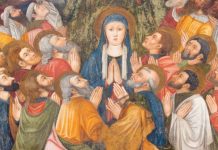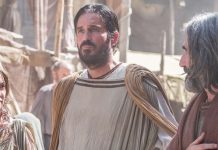
by Rev. Bertrand Buby, SM, PhD
See the end of this article for an Expanded Study Guide and Additional Reading.
John’s Gospel, the last to be written (between 90 and 100 a.d.), is often called a spiritual Gospel, and the author has been called a theologian by John Chrysostom and other Fathers of the Church. In fact, the earliest traditions have named the Apostle John as being the Beloved Disciple and the author of this Gospel. These traditions are very much alive in the Church today, even though scholars wrestle with questions about who wrote the Gospel and who the Beloved Disciple is. As far back as the third century, Origen of Alexandria was convinced of this tradition.
The inspired writer of this Gospel displays evidence of his knowing the other Gospels (Mark, Matthew, and Luke—the Synoptic Gospels). John, however, did not depend on these other Evangelists for his point of view and for the content he handed down to us. Rather, his has been named a maverick Gospel.
The Parables in John?
In John, we find only one section that may be similar to the parables in the New Testament—namely in chapter 10:1-18, where two pictorial discourses are blended into the theme of the Gate of the Sheepfold and the Good Shepherd. John calls these discourses paroimia and uses that Greek term for various figures of speech that formulate the words of Jesus and speak of his person throughout the 21 chapters of this Gospel. In fact, John is the only Evangelist who does not use the word parable (parabole); rather, he prefers paroimia and uses it four out of the five times it is mentioned in the New Testament.
I think this word paroimia will help us better understand the words and images that Jesus uses in a lofty manner of speaking in this more theological Gospel. The corresponding word for paroimia in the Old Testament (Hebrew Scriptures) is mashal, which is an overarching classification of the following figures of speech: proverbs, pictorial discourses, hidden sayings, aphorisms, ethical teachings, practical wisdom, parables, and allegories.
Reading through the Gospel while remembering these different figures of speech will help readers see the difference between John and the Synoptics in expressing the teachings and words of Jesus. Moreover, the sayings of Jesus that are common to both Matthew and Luke are not found in John. The Synoptics use a source called “Q” both in a written and an oral form. “Q” means “Quelle” or “Source” in German and is used for the parallel passages found mostly in Matthew and Luke.
The Two Parts of John’s Gospel
John’s Gospel has been divided into two parts. The first part, or Book One, consists of the Signs of Jesus that are meant to lead to faith in his person; hence, it is called the Book of Signs (chapters 1 through 12). The second part, or Book Two, is given the name the Book of Glory. It easily could be called the Book of Love (agape) because of its frequent use of this word for all the embracing, transcendent, total self-giving love on the part of Jesus for his disciples and they for him—as we see especially in chapter 13.
There are seven signs in the Gospel of John, and they are meant to lead readers or members of John’s community to believe and trust in the person of Jesus. John does not use the word miracle for these signs because the disciples of Jesus are to look beyond the sign to its purpose, which is to lead them to believe in the reality of Jesus present in their midst and to experience Jesus as a totally human person as well as the Divine Word of God.
Here are the seven signs that act like a paroimia in action:
1. Jesus changes water to wine at Cana (John 2:1-10)
2. Jesus heals an official’s son (John 4:46-54)
3. Jesus heals the lame man at the pool of Bethesda (John 5:1-9)
4. Jesus multiples the loaves at Passover (John 6:1-13)
5. Jesus walks on the water (John 6:16-21)
6. Jesus heals the man born blind (John 9:1-7)
7. Jesus raises Lazarus from the dead (John 11:1-44)
These seven signs accomplish the purpose of the Gospel: “Jesus performed many other signs as well—signs not recorded here—in the presence of his disciples. But these have been recorded to help you believe that Jesus is the Messiah, the Son of God, so that through faith you may have life in his name” (John 20:30-31).
“I AM” (Ego eimi)
In addressing those who gather to hear him, Jesus uses a unique expression that includes many symbols that tell people who he really is. We can easily observe these symbols by the way Jesus says “I AM” (Ego eimi).
The first use is found in chapter 4, where Jesus says to the Samaritan woman who suspects he is the Messiah, “I who speak to you AM he” (Ego eimi). The expression appears next in chapter 6 where, after walking on the waters, Jesus tells his disciples, “It is I (Ego eimi), do not be afraid.” And again, in the same chapter, Jesus says, “I AM the bread of life” (John 6:35). The expression will continue in 6:41, “I AM the bread of life come down from heaven.” It is reiterated in 6:48: “I AM the bread of life.”
Chapter 8 is especially important for the Ego eimi statements revealing who Jesus is. Jesus says, “I AM the light of the world. No follower of mine shall ever walk in darkness; no, he shall possess the light of life” (John 8:12). In 8:18 Jesus says, “I AM (Ego eimi) one of those testifying on my behalf, the Father who sent me is the other.” The strongest of the Ego eimi statements is found in verse 24 of the same chapter: “Unless you come to believe that I AM, you will surely die in your sins.” Then, as we will see later, Jesus associates the saying with his death on the cross: “When you lift up the Son of Man, you will come to realize that I AM and that I do nothing by myself. I say only what the Father has taught me” (8:28). And, shockingly, he says to his opponents, “I solemnly declare it, before Abraham came to be, I AM” (8:58).
The Ego eimi statements are the important words that identify Jesus with universal symbols like life, light, truth, bread of life, way, gate, shepherd, etc. They help us identify who Jesus is in the life of his disciples. The sayings are part of the purpose of this Gospel, which is to lead us to experience the person of Jesus in our own lives. Like the parables in Matthew, Mark, and Luke, the sayings in John teach us how to relate to Jesus’ words.
Pictorial Discourses in John
John does have two pictorial discourses that are similar to parables, but he does not choose to call them parables. Rather, he uses the multivalent word paroimia, which helps the Evangelist to illustrate who Jesus is and how he speaks. All of the figures of speech are meant to focus exclusively on the person of Jesus—both in his humanness and in his divinity. We are to believe in Jesus who is the Word of God become flesh (human) among us. John has only one objective: to bring us into the very presence of Jesus through a decisive act of faith in his person. John’s is a decision-making Gospel.
John’s Christology is a high Christology that tells us that Jesus and his Father are one. Jesus is equal to God in this Gospel, and those who do not agree with his saying this condemn him with blasphemy.
The Paschal Mystery in John
The Book of Glory or Agape leads us to spend a few moments on the meaning of the Paschal Mystery in this Fourth Gospel and how the Paschal Mystery is presented through two complementary phrases that point to Jesus’ suffering, death, and Resurrection.
The first phrase is actually the word hour which, in this Gospel, means the mystery of his passion, death, and Resurrection. The passages are found in John 2:4c (“…my hour has not yet come”); in 7:30 (“…his hour had not yet come”); 8:20 (“…because his hour had not yet come”); 12:23 (“The hour has come for the Son of man to be glorified”); and 12:27 (“’Father, save me from this hour?’ But it was for this that I came to this hour”).
The second phrase is used for the crucifixion of Jesus: being lifted up. In speaking to Nicodemus, Jesus says, “Just as Moses lifted up the serpent in the desert, so must the Son of man be lifted up, that all who believe may have eternal life in him” (3:14). Again, in 8:28, we read: “When you lift up the Son of Man, you will come to realize that I AM and that I do nothing by myself. I say only what the Father has taught me.” And the third proclamation is found in 12:32: “…and I—once I am lifted up from earth—will draw all men to myself.”
The spiral thinking of John and the symbolic words of Jesus always lead us to believe in the very person of Jesus. No matter what the image or discourse may be, we are always led to focus directly on Jesus through our decisive act of trust and faith in him.
Conclusion
We learn that John does contain many more figures of speech—not called parables—that give us the major points of Jesus’ teaching about who he is and what his mission is. All actions and words, signs and discourses, and aphorisms and metaphors are part of the literary make-up of the Fourth Gospel.
These different forms, however, are all directed to the perspective and point of view of leading readers to trust and believe in Jesus. Jesus’ basic message is that, as the Word made flesh, he has come to do the Father’s will. He is the Apostle sent from God to bring us the saving revelatory words found in the Gospel of John.
Father Bertrand Buby was ordained in 1964. He holds an LSS in sacred Scripture from the Pontifical Biblical Institute and a doctorate in Marian theology from the Marianum in Rome. Father Bert is a professor at the International Marian Research Institute, Dayton, OH. He has published a three-volume work titled Mary of Galilee; also With a Listening Heart: Reflections on the Psalms (Alba House).
Expanded Study Guide and Additional Reading
This is the sixth article in the 2013-2014 University of Dayton Catechist Formation Series titled “The Mystery and Wonder of the Parables.” Father Buby writes that the purpose of this article is to show the difference between the Synoptics—which present many parables—and John’s Gospel. John presents only one section that may be a parable, but he does not describe it as such. Actions and words, signs and discourses, and aphorisms and metaphors are part of the literary make-up of the Fourth Gospel. We discover in Buby’s article that the Ego eimi (I AM) phrases are Christological statements that are the key to understanding the hidden meaning of the discourses found in John’s Gospel.
Reflection Questions
1. What new insights did I receive concerning the author of the Gospel of John?
2. John does not use the word parable (parabole). What does he use? Is there a corresponding Hebrew word that I have read in another article in this series? (Identify.)
3. What is not found in John but is integrated into the other Gospels? (Be specific.)
4. What are the two parts of John’s Gospel? How are they divided? What are they called?
5. Why does John not use the term miracle but rather speaks of signs?
6. Identify the seven signs in John’s Gospel that act like a paroimia in action.
7. Father Buby indicates that “to believe in Jesus” is often used in the Gospel of John. Why does John use this phrase so frequently? How can I apply it to my spiritual life and study of the Scriptures?
8. What are the unique expressions (sayings) Jesus uses to tell people who he really is? (Give examples.)
9. What is the primary objective of John’s Gospel?
10. John’s Christology (study of Christ) is high Christology? What does this mean?
11. What are the hidden or symbolic phrases that John uses to describe Jesus’ mission?
Exercises
1. Create a graph that illustrates to your students how the composition of the Synoptic Gospels differs from John’s Gospel. Discuss the differences for easy navigation of the Scriptures.
2. John’s Gospel is divided into two parts. Book One consists of the Signs of Jesus (Chapters 1 through 12). Discuss with students why John calls these “signs” not “miracles.” Invite students to produce an artistic presentation/interpretation of the seven signs using either PowerPoint or posters.
3. The “I AM” (Ego eimi) sayings are unique to John. Invite students to create coats of arms that incorporates all of the symbols related to Jesus’ sayings. Have students explain their coats of arms and then create an exhibit of them in the parish or school.
Additional Reading
Bailey, Kenneth E. Jesus Through Middle Eastern Eyes (Part 6: Parables of Jesus). Downers Grove, IL: InterVarsity Press, 2008
Bausch, William J. In the Beginning, There Were Stories: Thoughts About the Oral Tradition of the Bible. New London, CT: Twenty-Third Publications, 2004
Kelly, Joseph F. An Introduction to the New Testament for Catholics. Collegeville, MN: Liturgical Press, 2006
Reid, Barbara E. Parables for Preachers (Year A, B, and C). Collegeville, MN: Liturgical Press, 2001, 1999, 2000
Copyright 2014, Bayard, Inc. All rights reserved. This article is protected by United States copyright and other intellectual property laws and may not be reproduced, rewritten, distributed, redisseminated, transmitted, displayed, published or broadcast, directly or indirectly, in any medium without the prior written permission of Bayard, Inc.




